2018 Annual Report

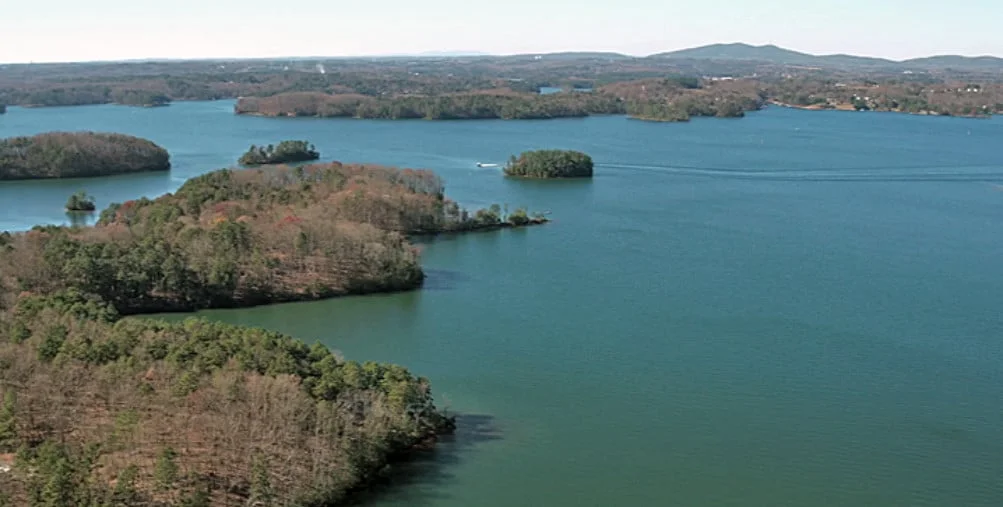
Reflections From The Road
By Jennifer Harper, Reserve Manager
Recently, I was able to take a much-needed vacation and despite all the rain, we were able to see family and some amazing countryside. I’m lucky that my husband and son are adventurous types, and after the promise of new and exciting experiences, they agreed to drive to New Hampshire. The first leg of our trip took us straight up through the Apalachicola-Chattahoochee-Flint Watershed; past Bainbridge, past Columbus and finally past Atlanta. Part of our mission at the Reserve is to help people appreciate the immensity of the watershed and understand that we are all connected by the water in the system. We hope that visitors leave with this knowledge, but how do we get the message out to people who have never been to Apalachicola Bay?
The answer to my question (well, at least one answer) came not so subtly along Rte. 81 through Virginia, West Virginia, Maryland, and Pennsylvania. Signs alongside the road proclaimed that the rivers and streams we crossed were part of the Chesapeake Bay Watershed. That seems simple enough. Our trip took us across the Delaware, Hudson and Connecticut Rivers and my thoughts wandered to how many of our Reserves are connected to inland areas by these essential lifelines. Again, how do we teach people that they are all part of something bigger?
We didn’t make it across the Piscataqua River into Maine (next time!), but we did spend a wonderful afternoon at the coast. Pretty soon, it was time to make the long trip home. As we headed through Hartford and we crossed the Connecticut River, my husband asked, “Is this the same river that’s near your parents in New Hampshire?” Yep, it is. It’s neat to think how water unites us or sometimes divides us. It is one of the most – if not the most – important natural resource we have, and it is ours to conserve and protect.
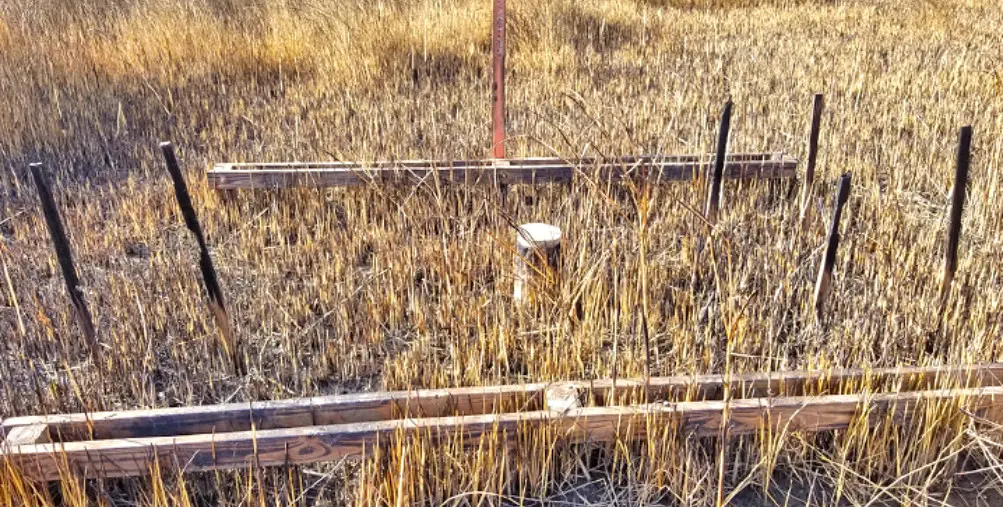
Research & Monitoring
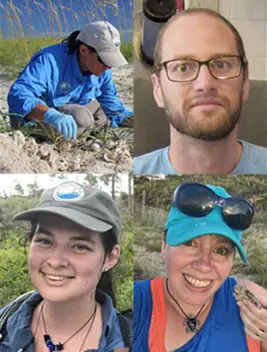
Reserve Research staffers, Megan Lamb, Ethan Bourque, Emily Jackson and SGI Volunteer Turtle Program cordinator Janice Becker.
Staff changes – In June, Research Biologist Lauren Levi retired after nearly 20 years of service. Jason Garwood, the Reserve’s fisheries biologist is now Research Coordinator. Megan Lamb oversees the Reserve’s biological monitoring and conducts research on sea turtle nesting temperatures. Ethan Bourque is now a Research Assistant and will oversee nutrient and meteorology data collection programs and conduct research on Apalachicola Bay’s net ecosystem metabolism. Emily Jackson, from the Coastal Training Program has transitioned into the Water Quality Technician position.
System Wide Monitoring Program Activities – The Reserve participates in NOAA’s system-wide monitoring program (SWMP) collecting high-frequency (15-minute interval) data on the Apalachicola Bay system. The 2017 data is available at cdmo.baruch.sc.edu.
Sentinel Sites and Surface Elevation Tables (SETS) – The Reserve has been installing and maintaining sampling stations, or Surface Elevation Tables, around the Apalachicola Reserve system. These record millimeter scale changes in marsh surface elevation and allows us to collect data on how area marshes will respond to changes in sea level.
The Little St. Marks and Pilot’s Cove sites now include porewater monitoring (a NOAA Sentinel Site requirement) to record data every 15 minutes to measure the sediment pore- water quality in the marsh. These stations also suffer little damage during prescribed burns and provide useful data on the marsh’s response to fire.
 Loggerhead Sea Turtle Nest Incubation Study – In 2016, the Reserve began monitoring the incubation temperatures of loggerhead sea turtles (Caretta caretta) on Little St. George Island. The incubation temperature of a nest determines the sex of hatchlings, the warmer the nest, the more females hatch. Preliminary data collected in 2016 - 17 measured incubation temperatures above the temperature which produces half female and half male hatchlings indicating hatchling production may be skewed towards females. Temperature loggers have been placed in nests for the 2018 season and data analysis is ongoing.
Loggerhead Sea Turtle Nest Incubation Study – In 2016, the Reserve began monitoring the incubation temperatures of loggerhead sea turtles (Caretta caretta) on Little St. George Island. The incubation temperature of a nest determines the sex of hatchlings, the warmer the nest, the more females hatch. Preliminary data collected in 2016 - 17 measured incubation temperatures above the temperature which produces half female and half male hatchlings indicating hatchling production may be skewed towards females. Temperature loggers have been placed in nests for the 2018 season and data analysis is ongoing.
Volunteers / Internships – The Reserve’s Volunteer program continues to grow and contribute a substantial amount of time and effort. Last year the Research section volunteers logged over 1,700 hours in activities including field work, the St. George Island volunteer “turtlers,” and the new citizen science microplastics project.
St. George Island Volunteer Turtle Program, Volunteers and Internship - Nest protection is a seven day per week task and volunteers and staff routinely meet the challenge. Janice Becker, the volunteer coordinator and Morgan Perry, a NOAA intern funded by Friends of the Reserve, coordinate the group’s conservation effort.
Citizen Science Microplastics Research – The Reserve started a volunteer-run program to sample water and sand for microplastics. Citizen scientists collect and process samples from seven area sites four times a year. These data help direct research into the sources and prevention of this form of pollution.
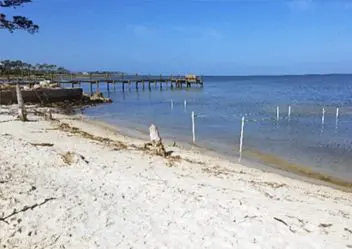
The Conservation Corp of the Forgotten Coast assisted getting the living shoreline project on St. George Island off the ground.
Outside Research Coordination – In addition to the research projects the staff oversees, they provide substantial support to visiting researchers from universities and government agencies. These include:
Intertidal Oyster Research
Dr. Stephen Durham, a DEP paleo-biologist, is conducting research on intertidal oyster reefs as a part the Statewide Ecosystem Assessment of Coastal and Aquatic Resources (SEACAR). He will be collecting data on the historical average body size of oysters.
Dr. Michael Martinez-Colon of Florida Agricultural and Mechanical University is studying benthic foraminifera, microplastics, and heavy metal pollution within sediments.
Barry Walton, an FSU graduate student, is studying abundance and movement of hard-head (Ariopsis felis) and Gaff-topsail (Bagre marinus) catfishes.
Eric Weingarten, a University of Mississippi doctoral candidate, is researching the influence of salinity, sediment depth, and spatial scales on wetland bacterial communities.
Dr. Andy Gannon, of Birmingham Southern College, is studying changing salinity patterns in the Apalachicola Estuary and effects on blue crab (Callinectes sapidus), collecting parasites from the gills of the crab, and funding an undergraduate intern to help process samples.
Mariamar Gutierrez-Ramirez, a University of Massachusetts PhD. Candidate, is studying the duration of migratory bird stays and how it is influenced by the body condition and habitat quality.
Jason Garwood, ANERR’s Research Coordinator, is collaborating with the Florida Fish and Wildlife Conservation Commission and the Fisheries Independent Monitoring Program to study salinity thresholds of juvenile fish and invertebrates. Researchers are also collecting data on habitat preferences of the area’s commercial White shrimp (Litopenaeus setiferus).
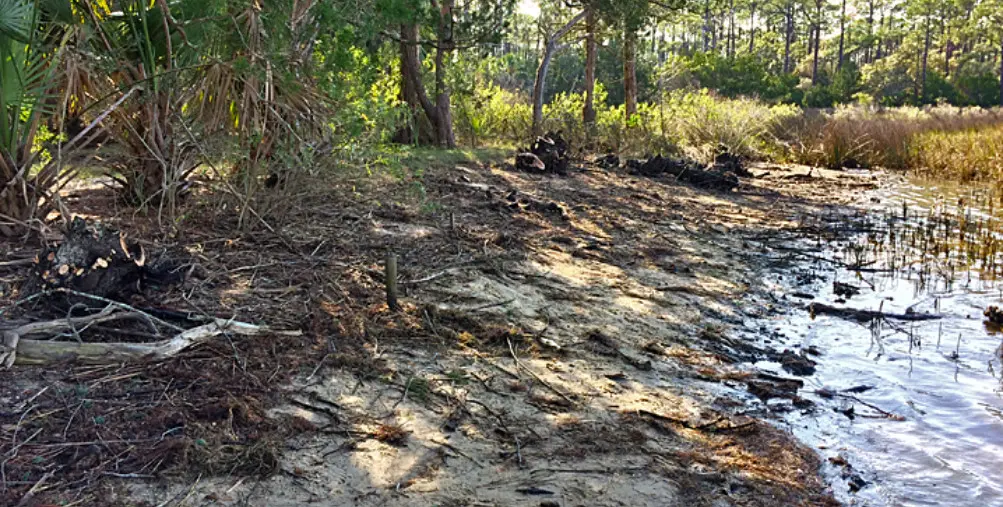
Stewardship
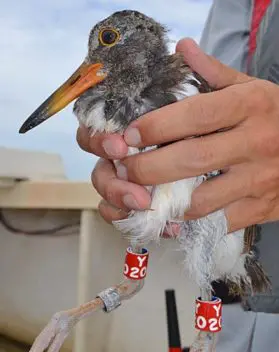
Buffer Preserve staff assisted Audubon with American oystercatcher banding efforts.
The primary goal for Stewardship is to protect Reserve-managed lands from impacts which degrade natural communities and affect adjacent water quality. The stewardship program focuses on habitat restoration/maintenance, listed species protection, invasive species control, land acquisition, protection of cultural resources and providing public use/access of suitable upland recreational areas. This sector works with the Research, Education and Coastal Training Program sectors to promote and practice informed stewardship of upland and aquatic resources to conserve the area’s natural biodiversity through applied research and education. ANERR also relies heavily on partnerships with other land managers and conservation groups to accomplish common goals of conservation land restoration.
Resource Management - The Reserve continues to build a strong fire team under the leadership of Dylan Shoemaker, Manager of the St. Joseph Bay State Buffer Preserve. Staff assisted the Buffer Preserve with burning over 900 acres this season as well as Nick’s Hole on St. George Island. Staff also worked with the Florida Forest Service to contain a wildfire near Sike’s Cut on Little St. George Island that burned 65 acres.
Staff completed baseline mapping efforts of mangroves at Pilot’s Cove, LSGI, SGI, St. Vincent NWR, Dog Island and Pig Island in St. Joseph Bay to monitor distribution of both black and red mangroves. Staff will continue mapping efforts and are tracking mangrove expansion with a newly formed regional mangrove group looking at mangroves in the Northern Gulf of Mexico.
Stewardship staff continue to monitor select listed species within the boundaries of the Reserve. The Reserve coordinates with Audubon Florida to monitor shorebirds and the Florida Fish and Wildlife Conservation Commission (FWC) to monitor nesting sea turtles on Little St. George Island. Staff recently assisted Audubon with banding two American oystercatcher fledglings at a new site that that was added to the FL shorebird database.
Staff completed the fourth year of biannual, long-term monitoring of emergent vegetation at two marsh locations on the Little St. Marks River and Little St. George Island.
Staff completed annual herbicide treatment of Chinese tallow on three acres located adjacent to a freshwater marsh at ANERR’s headquarters in Eastpoint. Staff also removed eight Tamarisk trees along 50’ of shoreline of St. George Island to allow the native marsh to recolonize.
Staff conducted annual surveys to assess and monitor cultural/historical resource sites within the Reserve’s boundaries.
Public Use - The Reserve partnered with the local Conservation Corps to repair portions of the Scipio Creek Boardwalk in Apalachicola. A new kiosk was installed that provides history on the area and shows a map of the .32-mile trail.
Staff, volunteers and the Conservation Corps continue cleanup efforts on Reserve-managed lands and have removed over 15,000 pounds of trash and debris this year.
New interpretive signage has been installed on Little St. George Island detailing the history of the island and the Marshall House. This fall will be the perfect time to explore the island’s trails.
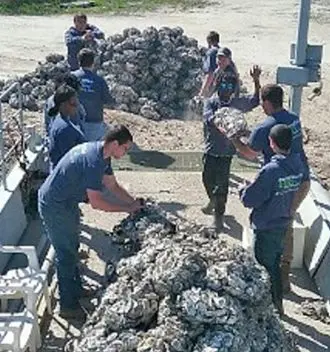
The Conservation Corp volunteers bag and transport oyster shell to St. George Island Living Shoreline infrastructure.
Millender Park improvements continued with the addition of sidewalks to the picnic pavilions. Future improvements for the park adjacent to the Visitor Center include and ADA-accessible observation platform and kayak launch.
Restoration - Stewardship staff worked with the local Conservation Corps to install a 250’ living shoreline on St. George Island to provide protection from erosion. Volunteers will plant native plants to restore marsh habitat.
Staff mowed and mechanically removed vegetation with help from the Conservation Corps on approximately 20 acres of wildland-urban interface lands to reduce fuels as part of the fire management program.
Partners - Staff actively participates in the Apalachicola Regional Stewardship Alliance (ARSA). Staff continue to collaborate with regional partners on land management issues, conservation activities, land acquisition proposals, restoration efforts, prescribed fire efforts and invasive species monitoring.
Staff continue to work with the Conservation Corps of the Forgotten Coast to accomplish many stewardship related activities such as restoration, public access/use and fire management. The group has provided over 6,700 hours of hands-on, demanding work in 2018.
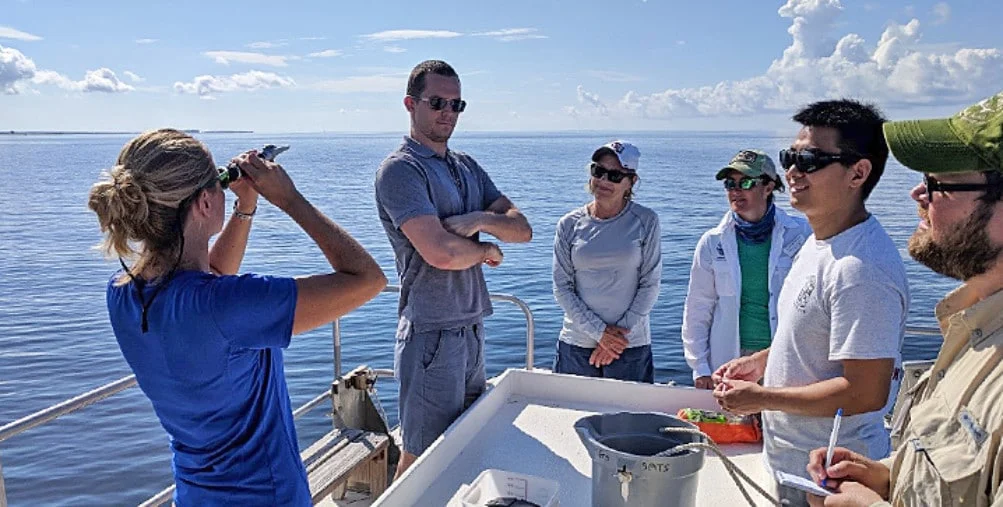
Education
This past year, a record number of nearly 30,000 people visited or took part in educational programs at the Reserve Nature Center. The majority were walk-in visitors (26,848) with educational programs accounting for the rest. Another successful year of fostering stewardship of the Apalachicola Estuary! The following is a summary of programs conducted this past year.
Group Programs – Program topics included ecology of oyster reefs, sea turtles, seining the littoral zone for juvenile fish and invertebrates, water quality sampling, and trips on the Tideline to study river floodplain ecology. The primary venue has been the Reserve’s center in Eastpoint at the outdoor classroom and Cat Point. Programs were also conducted on lands managed by the Reserve partners including the U.S. Forest Service and FDEP’s Division of Recreation and Parks on St. George Island. Nearly 3,000 people participated in activities at the Reserve.
 School Activities – ANERR Education Programs are focused on K-12 students and teachers in Franklin County and designed to support the tradition of stewardship of Apalachicola Bay. Every student in grades Pre-k, first, third, fifth and seventh participate in standards-aligned ANERR Education Programs on the ecology Apalachicola Bay and its value to the community. Sessions this past year included: A Home for Hermit Crab (Pre-k), Beach Scavenger Hunt (first grade), Saltmarsh Seining and Oyster Discovery Dig (third), Living Shoreline Assessment and Planting (fifth), Salt Marsh Food Webs and Soil Profiles (seventh), and the Settlement Study (tenth). Thanks to our Friends of the Reserve citizen organization for funding transportation and substitute teachers.
School Activities – ANERR Education Programs are focused on K-12 students and teachers in Franklin County and designed to support the tradition of stewardship of Apalachicola Bay. Every student in grades Pre-k, first, third, fifth and seventh participate in standards-aligned ANERR Education Programs on the ecology Apalachicola Bay and its value to the community. Sessions this past year included: A Home for Hermit Crab (Pre-k), Beach Scavenger Hunt (first grade), Saltmarsh Seining and Oyster Discovery Dig (third), Living Shoreline Assessment and Planting (fifth), Salt Marsh Food Webs and Soil Profiles (seventh), and the Settlement Study (tenth). Thanks to our Friends of the Reserve citizen organization for funding transportation and substitute teachers.
Oyster Substrate-Settlement Research Study - Each March for the past eight years, tenth grade students measured the size and number of oysters that settled over the previous ten months in collection trays on three substrate materials: limestone, fossilized shell and processed shell. Sample trays were submerged the previous May at Cat Point. The May to March timeframe coincides with the two primary seasonal settlement periods for oysters. This activity provides an opportunity to experience authentic science and explore conditions necessary for a healthy estuary.
Living Shorelines – Fostering Stewardship
The Reserve’s Education programs provides an opportunity to build stewardship through experiences that promote awareness, understanding and ownership of the watershed. One example are the activities that connect fifth and seventh grades. Fifth-graders participate in a living shoreline restoration program by planting plots of Saltmarsh Cord Grass at Cat Point. They make careful measurements to assess the status of restoration. Restoring the grass beds supports the development of new habitat for estuarine fauna. Two years later, they return as seventh graders to measure the development the habitat. By measuring the population level of the marsh periwinkle snail, an indicator species, students determine the abundance of snails. That abundance represents an essential link in a food web that begins with the sun and connects through the snails to many animals that depend on them for food.
Presentations – Summer Turtle Talks continued every Wednesday afternoon with nearly 1000 visitors attending during the summer. Our natural history lecture series, Reserve Wednesdays, continued with programs from Sept. through May on the third Wednesday of each month. This year topics were: Diamondback Rattle Snake Research, Freshwater Turtles and Snakes of Florida, Shellfish Harvesting, Black Bears, Bald Eagles, Apalachicola National Forest Management, Raptors, Historic Watercraft, Wildflowers and Oyster Reef Communities.
Publications – Two issues of the Reserve’s newsletter and an annual report were printed this year and distributed to nearly 800 subscribers via print or e-copy.
Teacher’s on the Estuary (TOTE) – Staff facilitated a 15-hour NOAA sponsored professional development program for teachers about estuary education content and curriculum opportunities. The program was coordinated with the Florida State University Coastal and Marine Laboratory and the FSU Department of Oceanography. Sessions included Experimental Design, Inquiry-Based Teaching, Intertidal Ecology, Learning Cycle Pedagogy, Measuring the Motion of the Ocean in Spatial and Time scales and the Reserve System Wide Water Quality Monitoring Program.
Estuaries Day - Another record year! Over 1000 people participated in this year’s Estuaries Day event with 33 staff and 78 volunteers coordinating many fun, learning activities. Support included local citizens & representatives from the following: FWC, US Fish & Wildlife Service, UF IFAS County Extension Office, SGI State Park, FSU Education & Outreach, Gulf Specimen Lab, SGI Volunteer Sea Turtle Program, WFSU Education & Outreach Program, Apalachicola Riverkeepers, Franklin County Consolidated School Culinary Program & NEST Program, ABC School Beta Club, Supporters of St. Vincent’s and Friends of the Reserve.
Activities added this year included the “Leave No Trace Race” hatchling game, mock sea turtle nest evaluations, monarch butterfly tagging demonstrations, pin the tag on the monarch game, making seed bombs, and a marine debris and recycling activity area. We brought back the blue crab molting tanks, the Gulf Specimen Lab’s Sea Mobile, lionfish education and beekeeping demonstrations. The yearly favorites were included as well; free t-shirts, touch tanks, cast net game, waterfront race and bingo.
Estuary Awareness Survey - In late 2015, Education staff initiated a survey to assess the effectiveness of the new Reserve film, The Apalachicola River and Bay: A Connected Ecosystem. The survey was designed to assess our visitor’s awareness and understanding about estuaries. Prior to the installation of the film in 2016, 120 randomly selected participants took the survey. Following installation, 100 participates were surveyed and the results indicate significant increases in visitor understanding of “Estuary Location” (fresh/salt water mix), “Watershed Location” (geographic breadth of the watershed -Flint and Chattahoochee Rivers) and “Ecosystem Services” (seafood productivity/dependence on estuaries).
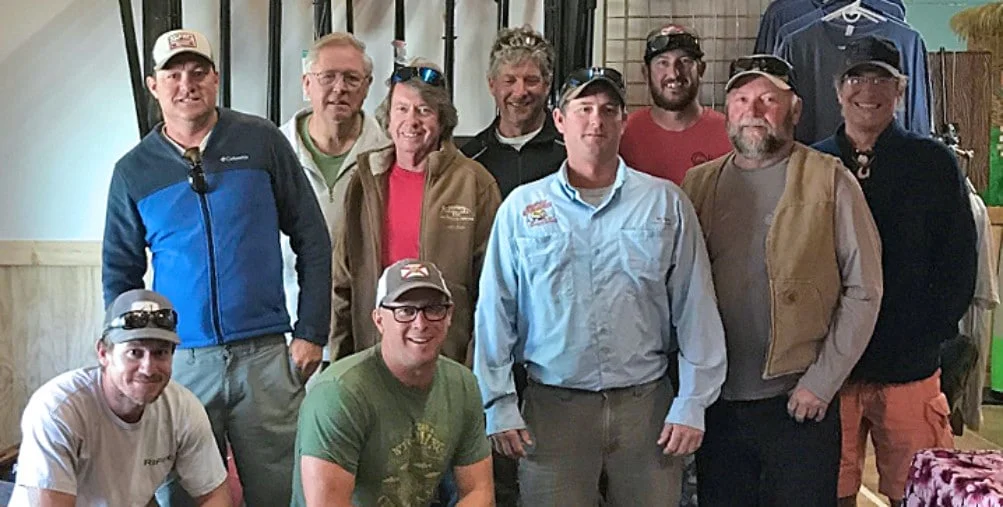
Coastal Training Program
The Coastal Training Program (CTP) seeks to bring the best available science and tools to decision makers in our watershed enabling them to make good decisions about the management of coastal resources so vital to health of our estuary, our economy and our way of life. Decision makers include elected and appointed officials, city and county planning staff, residents, business owners and nonprofit groups.
Over the past year, CTP Coordinator Anita Grove and CTP Specialist Emily Jackson offered twenty-five formal training programs on topics ranging from coastal vulnerability and resilience to bay-friendly landscaping and oyster ecology. We also seek to provide technical assistance to city and county staff and community boards and collaborate with professional groups and residents to increase community stewardship and conservation through engaging trainings.
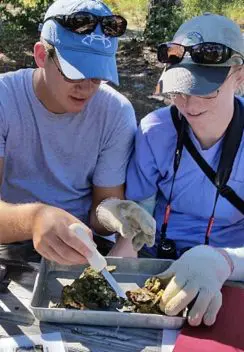
Participants in “Oysters 101” investigate colonies of organisms in an oyster reef cluster.
Trainings - This year, twenty-five formal, evaluated training programs were offered to 293 participants between July 1, 2017 and June 30, 2018. This equates to 122 hours of training. Course topics included flood plain management and coastal resilience, water conservation, estuary ecology and bay-friendly living. Highlights from this year’s programs include hosting a vulnerability workshop in conjunction with City of Apalachicola in October. We also hosted one of the state’s first living shorelines master naturalist classes with former CTP Coordinator Rosalyn Kilcollins.
Reserve Stewardship lead Kim Wren and CTP Coordinator Anita Grove worked to evolve the newly established Panhandle Estuarine Restoration Team (PERT). The group formed to help increase the use of living shorelines in the panhandle, develop best practices and improve materials used in establishing living shorelines. This group is a collaboration with FWC, NOAA, the Northwest Florida Aquatic Preserves, National Fish & Wildlife Service, St. Andrews RMA, Choctawhatchee Basin Alliance, The Nature Conservancy and Bay County IFAS extension office.
Several times each year CTP offers workshops to increase stewardship around the bay and river. Bay-Friendly Landscaping incorporates green infrastructure and Florida Friendly Landscaping™ techniques that help create natural shorelines and eliminate yard chemicals and toxins from entering the bay. Oysters 101 examines the critical role oysters play as a “keystone species” in the bay, and the Estuary class illustrates the importance of estuaries and the impact they have on our lives. We are developing a new workshop focused on the Apalachicola River and its floodplain that will be offered starting in the fall of 2018.
Performance Measures - Participants at our trainings fill out a two-page evaluation. Evaluations are analyzed after the trainings to gauge the effectiveness of our programs and are submitted the NOAA Coastal Training Program Performance Database. All participants are also surveyed about future trainings they would like to see offered.
Meeting Needs - The CTP Coordinator attends Franklin County Commission meetings, Apalachicola City Commission meetings and monthly Apalachicola Planning and Zoning meetings.
Getting the Word Out - CTP and Communications email targeted audiences, post workshops to Eventbrite, Facebook and several government and community web-based calendars such ApalachicolaReserve.com and FloridaDEP.gov. Press releases are distributed to all local and Florida panhandle media.
Outreach - CTP staff provided assistance to the City of Apalachicola Planning and Zoning Board, Franklin County planning and zoning office and the Franklin County Local Mitigation Strategy Committee. We partnered with the City of Apalachicola to host workshops on water conservation and the Apalachicola Vulnerability Study. We hosted a workshop for eco-tour guides and charter captains on nesting sea turtles and shorebirds, new oyster studies being conducted, tips to help injured wildlife and interpretive
site changes on Cape St. George.
Engagement with National, Regional and Local Partners - The CTP Coordinator and Specialist attended all CTP conference calls and webinars. The Coordinator attended the NERR annual meeting in Texas, served on the National Product and CTP sector planning committees for the 2017 annual meeting. The CTP Coordinator also serves on the IFAS Extension/SeaGrant program advisory committee, the Apalachicola Tree Committee, the Panhandle Estuarine Restoration Team and participates in the monthly national Living Shorelines call hosted by Restore America’s Estuaries.
